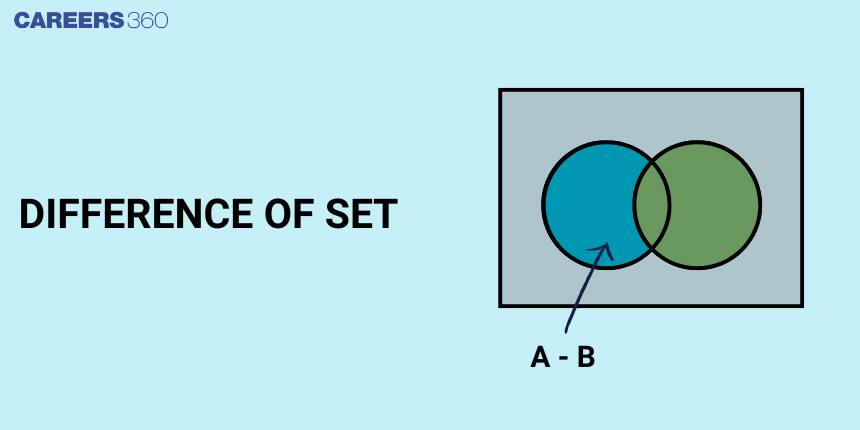Difference of Set: Definition, Formula, Properties, Examples
The difference between the two collections is a concept that examines the presence of elements in one collection but not in another. For instance, consider two groups of employees in a company; In one group, some members participated in a mandatory training session, but the other group did not participate in it at all. Therefore, the possibilities in the second set that are not in the first set indicate the number of employees who have not experienced the training. This operation is essential for defining the specific problem and issue domains or domains that require a solution in specific sectors or segments within a broad classification.
JEE Main: Study Materials | High Scoring Topics | Preparation Guide
JEE Main: Syllabus | Sample Papers | Mock Tests | PYQs
- What is Difference of sets?
- Properties of Difference of Sets
- Symmetric Difference of Sets
- Solved Examples Based On the Difference of Sets

In this article, we will cover the concept of the difference of sets. This concept falls under the broader category of sets relation and function, a crucial Chapter in class 11 Mathematics. It is not only essential for board exams but also for competitive exams like the Joint Entrance Examination (JEE Main), and other entrance exams such as SRMJEE, BITSAT, WBJEE, BCECE, and more. Over the last ten years of the JEE Main exam (from 2013 to 2023), a total of one question has been asked on this concept, including one in 2021.
What is Difference of sets?
Difference of sets is one of the fundamental operations in the concept of sets. It has various applications in concepts involving a specific category. Before looking into the concept of difference of sets, let us see what are sets.
Set
Sets are a foundational concept in mathematics, central to various fields such as statistics, geometry, and algebra. A set is simply a collection of distinct objects, considered as a whole. These objects, called elements or members of the set, can be anything: numbers, people, letters, etc. Sets are particularly useful in defining and working with groups of objects that share common properties.
It is a well-defined collection of distinct objects and it is usually denoted by capital letters A, B, C, S, U, V…...
Difference of Sets Definition
The difference of sets
Symbolically, we write
How to find the difference of sets?
To find the difference of sets,
- Identify the given non-empty sets and write them in set-builder form.
- Identify the order of difference, i.e., if to find
- Find the intersection of the sets
- Eliminate the elements of
- Define the new set as
Now, let us look into difference of set example for better understanding.
Difference of Set Examples
1.
then,
2.
3.
Now,
4.
Difference of Set Venn Diagram
The difference of sets

For instance, The difference of sets venn diagram of

From the venn diagram,
Properties of Difference of Sets
1. In general
2. When we take the difference of the same set then the result is empty. (i.e)
3. When we take the difference of a finite set with the null set then the result is a finite set. (i.e)
4. When we take the difference of a finite set with a universal set then the result is empty. (i.e)
5. The sets

Symmetric Difference of Sets
Symmetric difference of two sets
The symmetric difference of sets can be found with the help of the following steps:
- Identify the given non-empty sets and write them in set-builder form.
- Now find the difference
- Now find the union of those sets
Symmetric Difference of Sets Examples
1.
then,
2.
3.
Now,
4.
Symmetric Difference of Set Venn Diagram
The symmetric difference of sets

For instance, The difference of sets venn diagram of

From the venn diagram,
Recommended Video Based on Difference of Sets
Solved Examples Based On the Difference of Sets
Example 1: If
1)
2)
3)
4)
Solution:
Clearly, as the sets in the question and in the third option, both equal the symmetric difference of
Hence, the answer is the option 3.
Example 2:
Solution:
Hence, the answer is 832.
Example 3:
Let
1)
2) If
3)
4) If
Solution:
So, option (1) is true
Let
Let
Now,
From (1) and (2)
=> Option (3) is correct.
For
So, option (4) is not true.
Example 4:
If
1)
2)
3)
4)
Solution:
Hence, the answer is the option 2.
List of Topics Related to Difference of Sets
Frequently Asked Questions (FAQs)
The difference of set definition is,
The intersection of any two of these sets is the null set is called a disjoint set.
The symmetric difference of two sets
The set difference of set A with null set is
No,
Also Read
13 Feb'25 11:56 AM
08 Feb'25 06:36 PM
20 Jan'25 04:44 PM
20 Jan'25 04:40 PM
20 Jan'25 04:39 PM
18 Dec'24 01:59 AM
18 Dec'24 01:57 AM
18 Dec'24 01:49 AM
18 Dec'24 01:11 AM
18 Dec'24 12:58 AM
